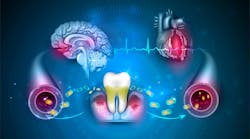Editor's note: This is part one of a two-part series. Read part two here.
The continuous presence of periodontal pathogens, alongside the body’s immune reaction, prompts the release of pro-inflammatory cytokines, matrix metalloproteinases, and reactive oxygen species (ROS). This sequence results in the deterioration of collagen fibers, loss of alveolar bone, and weakening of the periodontal ligament. However, the impact extends beyond oral health. Evolving research has highlighted numerous links between periodontitis and conditions such as cardiovascular disease, type 2 diabetes, and cognitive impairment, with some studies indicating that mitochondrial dysfunction may play a pivotal role in these associations.
Mitochondria, found within eukaryotic cells, are often described as “energy factories” due to their crucial role in producing adenosine triphosphate (ATP), which is vital for energy metabolism. Apart from this primary function, mitochondria are essential for diverse cellular processes such as mitophagy, regulating ROS, and facilitating signaling transduction.
Relationship between periodontitis and mitochondria
Recent research suggests that dysfunctional mitochondria significantly contribute to the onset and tissue damage linked with periodontitis, primarily by inducing oxidative stress (OS), inflammation, and initiating mitochondria-mediated apoptosis.1,2 This dysfunction and the resulting downstream effects are critical pathological hallmarks seen in both periodontitis and various systemic diseases.3
ROS, natural by-products of cellular oxygen utilization for energy, are predominantly generated by mitochondria, the cell’s powerhouses, during routine functions. Typically, about 90% of cellular oxygen consumption occurs within mitochondria, yielding approximately 1%–5% as ROS.4 The primary ROS types in our physiology include the superoxide anion free radical (O2-) and hydrogen peroxide (H2O2), which can originate from chemical reactions in mitochondria, the endoplasmic reticulum (ER), and peroxisomes, as well as from external sources such as diet, toxins, and radiation. ROS have the potential to induce damage to DNA, proteins, and sugars through interactions with iron ions. However, they also serve as signaling molecules in cellular pathways influencing immunity, growth, and aging.
Maintaining a balance between ROS production and removal is essential for proper cellular function. OS happens when there’s too much ROS and not enough antioxidants to clear them from the body. This imbalance disrupts signaling pathways and damages molecules. Since mitochondria produce most of the ROS, problems with how they work can lead to mitochondrial dysfunction, showing up as a loss of mitochondrial membrane potential (MMP). MMP plays a crucial role in various mitochondrial functions, including ATP production, regulation of ROS generation, and the control of mitochondrial permeability. Changes in MMP can indicate alterations in mitochondrial function and are often associated with cellular stress, apoptosis, and other pathological conditions.
Perio pathogens’ virulence factors on mitochondria
In periodontal tissue, neutrophils react to the formation of pathogenic biofilms by generating bactericidal ROS. An overabundance of ROS can lead to tissue injury and worsen inflammation. As a result, neutrophils activate a specific antioxidant mechanism called the Nrf2 signaling pathway. Nrf2 not only aids in the formation of new mitochondria—essential for sustaining cellular energy production—but also regulates the expression of antioxidant enzymes, protecting the human body from OS while ensuring optimal mitochondrial function.5 In patients with severe periodontitis, the levels of Nrf2 and its downstream antioxidant enzymes are notably reduced in neutrophils.
As we all know, periodontitis is characterized by chronic infection and inflammatory destruction, with key pathogens including Porphyromonas gingivalis (Pg), Aggregatibacter actinomycetemcomitans (Aa), Tannerella forsythia (Tf), and Fusobacterium nucleatum (Fn). Studies have revealed that these pathogens target mitochondria, altering their structure and function.6 For example, Pg alters metabolic processes in macrophages and influences mitochondrial dynamics by enhancing fission in endothelial cells.7 Tf interferes with enzyme function within mitochondria, and Fn stimulates mitochondrial fusion in colorectal cancer cells.
Periodontal pathogens have the capacity to disturb the mitochondrial quality control (MQC) system, hindering the elimination of impaired mitochondria and intensifying inflammatory reactions. Lipopolysaccharide (LPS) derived from gram-negative bacteria, such as Pg-LPS, plays a role in mitochondrial dysfunction, OS, and disrupted energy generation.
Pg influences apoptosis in epithelial cells by initially resisting it to avoid host clearance, then later triggering caspase-independent mitochondrial apoptosis, which contributes to tissue damage.8 Pathogens also induce alternative forms of cell death, such as ferroptosis and pyroptosis.
Ferroptosis is a regulated cell death process caused by the iron-dependent buildup of harmful lipid peroxides, resulting from disruptions in antioxidant defenses and iron metabolism. Pyroptosis, on the other hand, involves cell swelling and rupture, releasing inflammatory cellular contents, and is often initiated by infections through the activation of inflammatory caspases. Ferroptosis-related genes are upregulated in Pg-LPS–treated cells and rat periodontitis models, leading to mitochondrial damage and increased ROS levels.9 Additionally, exosomes from Fn and Pg trigger inflammasomes, leading to the initiation of pyroptosis.
Mitochondria connect periodontitis with systemic diseases
Dysfunctional mitochondria play a pivotal role in connecting periodontitis with numerous systemic diseases. The entry of pathogens and their virulence factors into the bloodstream, causing bacteremia, can induce dysfunction in remote cells, thereby facilitating the development of systemic diseases.
Next month’s discussion will delve into this association, particularly exploring its implications for obesity, type 2 diabetes, cardiovascular disease, and cognitive impairment.
Editor’s note: This article appeared in the July 2024 print edition of RDH magazine. Dental hygienists in North America are eligible for a complimentary print subscription. Sign up here.
References
- Mottis A, Herzig S, Auwerx J. Mitocellular communication: shaping health and disease. Science. 2019;366(6467):827-832. doi:10.1126/science.aax3768
- Jiang W, Wang Y, Cao Z, et al. The role of mitochondrial dysfunction in periodontitis: from mechanisms to therapeutic strategy. J Periodontal Res. 2023;58(5):853-863. doi:10.1111/jre.13152
- Bullon P, Newman HN, Battino M. Obesity, diabetes mellitus, atherosclerosis and chronic periodontitis: a shared pathology via oxidative stress and mitochondrial dysfunction? Periodontol 2000. 2014;64(1):139-153. doi:10.1111/j.1600-0757.2012.00455.x
- Bolisetty S, Jaimes EA. Mitochondria and reactive oxygen species: physiology and pathophysiology. Int J Mol Sci. 2013;14(3):6306-6344. doi:10.3390/ijms14036306
- Chiu AV, Saigh MA, McCulloch CA, Glogauer M. The role of NrF2 in the regulation of periodontal health and disease. J Dent Res. 2017;96(9):975-983. doi:10.1177/0022034517715007
- Govindaraj P, Khan NA, Gopalakrishna P, et al. Mitochondrial dysfunction and genetic heterogeneity in chronic periodontitis. Mitochondrion. 2011;11(3):504-512. doi:10.1016/j.mito.2011.01.009
- Xu T, Dong Q, Luo Y, et al. Porphyromonas gingivalis infection promotes mitochondrial dysfunction through Drp1-dependent mitochondrial fission in endothelial cells. Int J Oral Sci. 2021;13(1):28. doi:10.1038/s41368-021-00134-4. Erratum in: Int J Oral Sci. 2022;14(1):3. doi:10.1038/s41368-021-00153-1
- Mei F, Xie M, Huang X, et al. Porphyromonas gingivalis and its systemic impact: current status. Pathogens. 2020;9(11):944. doi:10.3390/pathogens9110944
- Deng Y, Xiao J, Ma L, et al. Mitochondrial dysfunction in periodontitis and associated systemic diseases: implications for pathomechanisms and therapeutic strategies. Int J Mol Sci. 2024;25(2):1024. doi:10.3390/ijms25021024









